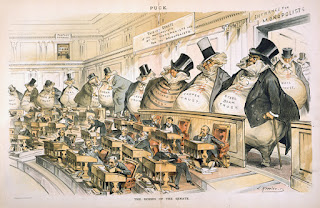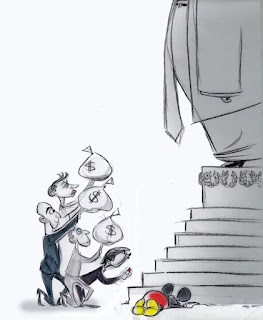There are not two sides to human rights. Period.
It should not matter your political party affiliation or what community you live in, if Americans cannot agree that everyone deserves human rights, then this will be the end of the United States.
Of course, the U.S. government has a long history of violating people's human rights (treatment of Native peoples, enslavement of African Americans, Japanese American incarceration during World War II, treatment of queer Americans, treatment of women, child labor, etc.). However, even during these unjust moments, Americans citizens would express a collective commitment to basic human rights (granted, some Americans were still excluded from those rights due to their race, gender, class, sexual orientation, abilities, religion, or immigration status). While those in power may have disregarded people's human rights, movements formed to ensure freedom and civil rights. In that context, pleas to value most opinions were valid. It did seem that there was potential for the United States to become more democratic and more just. (Note, I did not say all opinions were valid; it was never right to give value to the opinions of slavery proponents, segregationists, supporters of settler-colonialism, etc., for they wanted to violate people's human rights.)
Similarly, we once lived in a nation where different political opinions should have been respected in the classroom, as well. For many years, I taught conservative, liberal, progressive, and libertarian students in my high school social studies classroom. I taught during politically difficult moments, such as September 11th, the Iraq War, Hurricane Katrina, and the Great Recession. These events challenged me as a teacher to find a way to create a fair balance in my classroom, where honest student opinions could be heard. I did my best to give equal weight to different political views (which was not always easy in very politically liberal Massachusetts).
Sadly, that time has come to an end (at least for now and at least in the United States).
We no longer live in a nation that is engaged in an honest debate between different political ideas and policies. This is the precipice to the end of American democracy and the decline of American human rights. We need to start treating it as such in the classroom and beyond.
One political party has made clear that is does not have any care to follow any of the old democratic norms. That common ground of all political ideologies believing in human rights is over. Donald Trump and the current Republican Party are clearly willing to erode and possibly end democracy to rule in however way they see fit. They are continually ignoring the rule of law. They have no interest in listening to the views of Americans and governing according to their wishes. They are openly disregarding human rights, because they can. Not long ago, some members of the Republican Party showed alarm at Nixon's disregard for the law, police violence used on Rodney King, U.S. soldiers participating in torture at Abu Gharib, or (albeit very briefly) the January 6th Capitol Insurrection; today, this same party is widely unified in their cheering of similar incidents of constitutional and human rights violations by the Trump administration (see below). A lack of disagreement around these issues and shows how far past reasonable political debate we are and a sign that they are an authoritarian party (at minimum they should be described as a far right party).
In this current moment, it is especially crucial that social studies teachers do not fall into the "both-sides trap," or what media literacy scholars would call false balance. Not all stories have two equal sides (sometimes they have many sides or have primarily have one side). Not every historical event had two equal arguments for how things should have accrued. There were not two sides to the Holocaust, American slavery, colonization of Native people, Japanese American incarceration, and child labor. These events were wrong and unjust. Giving weight to counter-arguments, such as the Holocaust did not happen (a common conspiracy theory), downplaying the horrors of American slavery (commonly espoused by conservative politicians), denying atrocities and genocides against Native people (a fringe argument), Japanese American incarceration was justified (a fringe argument), or child labor was good for children (argued by some today), is dangerous. It opens the door for abhorrent ideas like slavery, genocide, mass murder, concentration camps, or child labor to return in the present. Similarly, there are not two sides to the eroding of American democracy and human rights. We are near the beginning of a very difficult and troubling timeline. As such, teachers must not give equal weight in their classrooms to arguments that support Trump disregarding the Constitution, ignoring the rule of law, or violating human rights. This is when teachers (and all Americans) must resist.
In this blog post, I hope to explain how history, government/civics, economics, geography, ethnic studies, and other social science teachers must use this journalism concept in their own teaching, especially when it related to the teaching of human rights in our current era of rising authoritarianism and politically-motivated cruelty. I don't write this post lightly. I understand how this may come across to some people, especially those who voted for or support Donald Trump. I know this is made harder by students (and parents and community members) who watch partisan media sources that do not have any commitment to evidence and are little more than political propaganda. Yet, I ask anyone of good conscious to look deeply at what is happening to the United States and try to understand why social studies teachers must play an important role in teaching against anyone's human rights being violated.
This time is different. Donald Trump and others in his administration (and we need to be clear that this is not only one person) represent the greatest threat to human rights in the 21st century. As the most economically and militarily powerful country in the world, their actions do not only effect Americans, but everyone across the entire globe. Teachers must understand this and realize that they have a responsibility to defend democracy and justice in this moment.
Six months ago, the Trump administration returned to power with Republican political control of Congress and the Supreme Court. Since then, the United States has quickly become an illiberal democracy, which Zakaria described as democratically-elected governments that ignores "constitutional limits of their power and deprived their citizens of basic rights and liberties" (you can watch an Associated Press clip on illiberal democracy in Hungary here). Historians and political scientists have described the Trump administration as authoritarian, white Christian nationalist, and fascist. At their core, all three of these movements are anti-democratic and anti-human rights.
The executive branch, with a general ignorance from both Congress and the Supreme Court, has detained migrants and some citizens without due process sending some to prisons in foreign countries, used the military to patrol citizens during peacetime, refused to release federal funds in education, health care, and the environment approved by a bipartisan Congress, essentially taken bribes from foreign governments and companies, and floated the idea that Trump may run for/is entitled to a constitutionally-prohibited third term. Here is a summary of the many constitutional violations by the Trump administration from law professor Steven Schwinn and the Leadership Conference on Human and Civil Rights lists the many human rights violations here. Each one of these are a small test to see if our democratic system will allow the Trump administration to violate the constitution and human rights. So far, each test has been successful and we are creeping further down the road to an illiberal democracy without human rights protections. But, all hope is not lost. As a number of scholars have argued, democracies can die (see here, here, here, here, here, and here), but they also can re-emerge (sometimes more vibrant than before) (see here, here, here, here, and here). Human rights can be restored. Here is a helpful list on how to save U.S. democracy from the Democracy Docket.
Defining Human Rights
Above: Eleanor Roosevelt holding poster of the Universal Declaration of Human Rights not long after its passage by the United Nations in 1948.
Human rights are rights inherent to all human beings, regardless of race, gender, class, sexual orientation, nationality, ethnicity, language, religion, or any other status. They are essential to defending humanity. They are a cornerstone of democracy. Without human rights, we cannot have a world of freedom and peace. The United Nation's "Declaration of Human Rights", created over 75 years ago, offers one framework to use with students. It outlines 30 articles that define what human rights include.
These include (I have chosen some that are particularly important for the current times):
- "The right to life, liberty and security of person."
- "No one shall be subjected to torture or to cruel, inhuman or degrading treatment or punishment."
- "Everyone has the right to recognition everywhere as a person before the law."
- "No one shall be subjected to arbitrary arrest, detention or exile."
- "Everyone has the right to freedom of thought, conscience and religion."
- "Everyone has the right to freedom of peaceful assembly and association."
- "Everyone has the right to a standard of living adequate for the health and well-being of himself and of his family."
Below, I list four topics and resources that social studies teachers can use to have students understand how abnormal the Trump administration's actions are within U.S. history and to consider ways that Americans can defend democracy and human rights. I have very intentionally included conservative, liberal, progressive, and libertarian sources, as well as mainstream and alternative media.
Issue 1: Treatment of Migrants and Use of Military/Law Enforcement Agents

"How Can the President Put Soldiers on the Streets of Los Angeles?" (Brookings Institute)
"The Law and Lawlessness of U.S. Immigration Detention" (Harvard Law Review)
"What Does “Due Process” Mean for Immigrants and Why Is It Important?" (Vera Institute of Justice)
"Trump Seizes Power Over D.C. Using Rarely Invoked Rule" (The New Republic)
"Pentagon Plan Would Create Military ‘Reaction Force’ for Civil Unrest" (Washington Post)
Issue 2: Attacks on Civil Rights
"Statement on the Trump Administration’s Attacks on Civil Rights (New York City Bar Association)
"The Human Toll of Trump's Anti-Trans Crusade" (American Civil Liberties Union)
"Trump on Voting Rights" (American Civil Liberties Union)
"Trump has put Christian nationalists in key roles" (The Guardian)
Issue 3: Disregard for the Constitution and Rule of Law
"Trump's Pardons: Political Violence, Hate Groups, and the Rule of Law" (Stanford Law School)
"Trump's Pardons for Rioters 'Disturbing,' Former Top Jan. 6 Prosecutor Says" (ABC News)
"Why DOGE Is Unconstitutional" (Washington Post)
"Trump Dismantling Education Department Violated Constitution, Lawsuits Say" (Democracy Docket)
"Trump’s Tariffs Are Unlawful: How the “Nondelegation Doctrine” Limits Congress" (The Fulcrum)
"President’s Third Term Talk Defies Constitution and Tests Democracy" (The New York Times)
Issue 4: Corruption
"Trump 2.0 and the Foreign Emoluments Clause" (American Enterprise Institute)
"Trump’s ‘Free’ Jet from Qatar and Corruption’s Slippery Slope" (American Oversight)
"The Number: How much is Trump pocketing off the Presidency?" (The Atlantic)
"Crypto, Wallets, Bibles: Trump's Assets top $1.6 billion in Latest Disclosure" (Axios)
"People Are Paying Millions to Dine With Donald Trump at Mar-a-Lago" (WIRED)
"The Government's Bar Tab at Mar-a-Lago" (WNYC)
"'What Life Is This?': The Crypto Investors Who Bought a Dinner with Trump" (Politico)

































